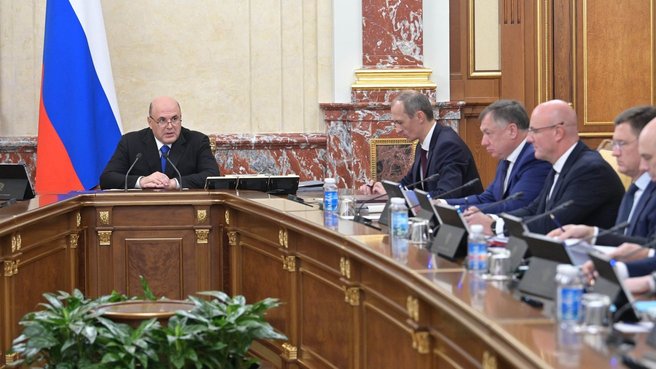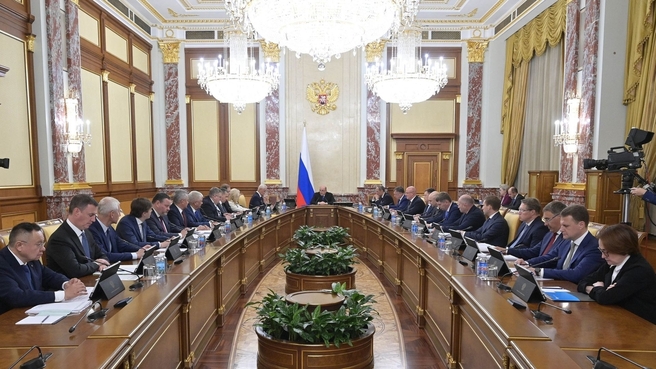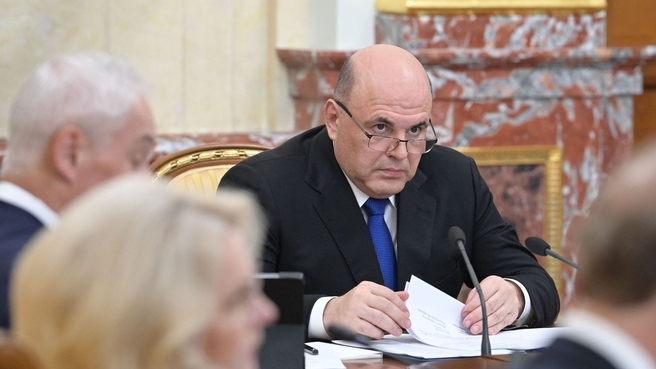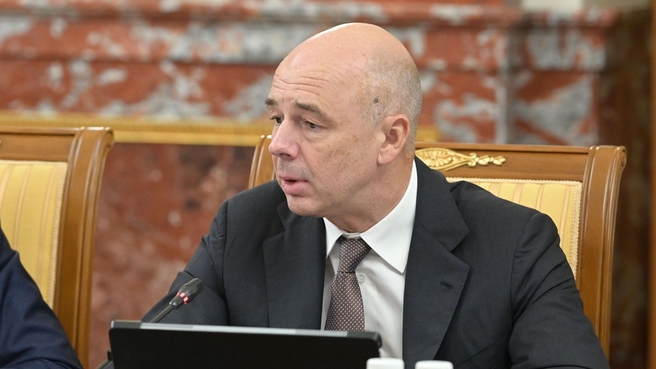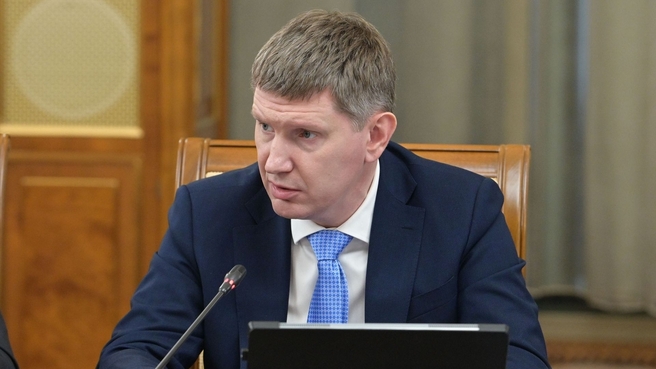Agenda: Drafts of the federal budget and state extra-budgetary funds, socioeconomic development forecast and the fundamental objectives for the government’s integrated monetary policy in 2024-2026, and issuing a grant to the Defenders of the Fatherland State Foundation.
Mikhail Mishustin’s opening remarks
Excerpts from the transcript:
Mikhail Mishustin: Good afternoon, colleagues.
In accordance with the Constitution of Russia and the Budget Code, the Government must submit the draft federal budget to the State Duma by 1 October.
We are finalising it today. Let’s review the current draft as well as the other documents that will be sent to the parliament, including the socioeconomic development forecast, the budgets for the two extra-budgetary state funds and a number of other documents. The state monetary policy guidelines will be presented by the Bank of Russia.
Work on the country’s main financial document continued amid increasing global imbalances. Global economic growth has slowed. This year’s growth may well turn out to be one of the lowest since the last international crisis in 2008-2009 – except, of course, the covid period.
Colleagues, I would also highlight the persisting external pressure on our economy.
Thanks to the implementation of the President’s instructions and prompt changes in the regulatory framework, the Government, in coordination with the Central Bank, has managed to respond to many challenges, support our citizens and our companies in various industries.
This year, we have already seen sustainable growth, contrary to the opinion of those experts who expected a far worse scenario.
According to preliminary estimates by the Ministry of Economic Development, gross domestic product increased by more than 2 percent in seven months. Importantly, this was largely facilitated by the growth of the manufacturing industry, as well as the restructuring of transport and logistics links and a revival of investment in the first half of this year.
The labour market situation remains stable.
We discussed our proposals and reported on them at length at a meeting with the President at the beginning of this week.
We did everything we could to make sure we took well-informed and appropriate decisions. Guaranteeing that the Government delivers on all its social commitments was the highest priority for us, just as the President has said. I can say that we provided funding for all of them without exception.
Of course, in our effort to achieve steady economic growth we sought to further develop supply-side economics by building on our national capabilities and resources. The key drivers here are investment and consumer demand, alongside an effort to expand manufacturing.
I suggest we begin with the socioeconomic development forecast. As usual, the Ministry of Economic Development drafted two versions, a baseline scenario, as well as a more conservative outlook. We relied on the baseline scenario when drafting the budget, which provides for keeping annual GDP growth rates above 2 percent.
We will focus our efforts to effectively achieve six priority objectives as outlined by the President. These include expanding foreign economic cooperation with promising partners from friendly countries and fine-tuning the relevant mechanisms for this, including in terms of transport and financial transactions. This also includes reinforcing Russia’s technological and financial sovereignty, anticipating demand for transport, utilities and social infrastructure by building more facilities like this, improving the wellbeing of our people, improving demographics, offering better social services and care for mothers and children, as well as supporting families with children.
Maxim Reshetnikov will elaborate on this forecast.
We outlined the key budget parameters based on the approaches approved during the meeting with the President.
Next year, we expect budget revenue to total 35 trillion roubles. This would be a substantial increase, resulting from our efforts to develop the national economy. Moreover, non-oil and gas revenue is expected to be two times higher than oil and gas revenue.
But spending will increase too. In 2024, it is expected to total 36.6 trillion roubles, which would be primarily attributable to higher spending on carrying out measures stipulated in the Presidential Address to the Federal Assembly. Some 3 trillion roubles will go towards national projects next year. Over 760 billion roubles will be channelled into carrying out the relevant socioeconomic development initiatives over a three-year period.
This way, we will not only finance all the commitments we have assumed, but also other priorities, which include supporting the most vulnerable social groups, reinforcing the country’s defence capabilities, integrating the new regions, as well as promoting technological development and building more infrastructure. We earmarked funding for all these priority undertakings in the three-year budget.
We did everything we could to make the budget deficit as small as possible. Most of this deficit will be covered by borrowings.
Minister of Finance Anton Siluanov will report on the budget today.
We will also discuss the main parameters for extra-budgetary funds for the next three years.
As I have said, our priority is to implement our social obligations, to enhance the efficiency and targeting of state social support, and to ensure that it is provided without delay.
The draft budget for the Mandatory Medical Insurance Fund stipulates an increase in spending on medical assistance in the regions. Next year, it will be increased by approximately 13.5 percent year on year. This is important for enhancing the accessibility of medical assistance and for paying salaries to doctors and other medical personnel in accordance with the standards set in the executive order signed by the President in May.
Funding has also been stipulated for medical rehabilitation, including post-covid care. This initiative of the President will help people overcome the consequences of their illnesses.
Over 130 billion roubles will be allocated next year for high-tech medical care outside the basic mandatory medical insurance programme. People living in the regions will retain the possibility of receiving such assistance at federal medical institutions. About 214 billion roubles will be earmarked for this.
We will continue to do whatever is necessary for the stable development of the national healthcare system.
The focus is on families with children. The Pension and Social Insurance Fund will continue to pay fixed-rate payment benefits to pregnant women in need and low-income parents with children up to 17 years. These monthly allowances will be paid to over 10 million families.
Substantial allocations have been stipulated under the maternity capital programme.
The fund’s obligations with regard to sick and maternity leave payments will be fulfilled in full. This also concerns pensions, with due regard for the upcoming indexation.
Another major issue has to do with increasing the minimum wage. We will do this ahead of schedule, as per the President’s instructions. The overall increase next year will be 18.5 percent, which is substantially higher than the inflation rate.
The minimum wage will be raised to more than 19,200 roubles on 1 January 2024. At the same time, the wages of over 4.5 million people will increase.
Today we will also discuss the rights of participants in the special military operation. Efforts in this sphere are underway, including at the Defenders of the Fatherland State Foundation set up at the President’s initiative.
The Government will issue a grant of over 5 billion roubles to the foundation for helping the veterans of the special military operation and their families, including in terms of medical rehabilitation, employment, education, legal support and a number of other measures, which the foundation provides to the participants of the special military operation and their families in all regions of Russia.
Let’s begin the discussion.
Finance Minister Anton Siluanov will present the draft federal law On the Federal Budget for 2024 and the 2025-2026 Planning Period.
Go ahead, please.
Anton Siluanov: Mr Mishustin, colleagues.
When forming budget parameters, we used socioeconomic development forecasts based on maintaining the positive dynamics of economic development. The growth rate in the three-year cycle is above 2 percent. The implementation of fiscal policy is planned in accordance with the logic of the budget rule and the gradual return to primary budget balance by 2025. This will help protect the economy and budget from external shocks.
The budget rule has undergone some changes. While
this year we calculated basic oil and gas revenues based on a nominal figure of
8 trillion roubles, next year we propose returning to the usual parameters for
calculating basic oil and gas revenues, based on the base price of oil, which
is 60 dollars per barrel and adopting it next year and in years to come. The
same price that, in fact, was included in the calculation of the base amount of
8 trillion roubles.
Over the next three years, budget policy will focus on funding all the commitments the Government has assumed and also the new priorities. This primarily includes social support for our people – we will make sure to provide funding for all the decisions which were taken in this sphere, as well as promoting technological development and expanding infrastructure, reinforcing the country’s defence capabilities, and fully integrating the new regions. The budget provides for all these priorities and backs them with the funding they require.
We also earmarked the necessary funding for carrying out the decisions from the Presidential Address to the Federal Assembly in 2024 and throughout the three-year cycle by allocating over 2.5 trillion roubles per year for implementing the decisions from the address. This primarily includes funding for paying out monthly benefits when giving birth and raising a child, ensuring the minimum wage grows faster than inflation, supporting participants in the special military operation and a host of other decisions.
We have also allocated the required funds – just under 3 trillion roubles – for carrying out national projects. The main tasks here include the national projects Demography, Safe Quality Roads, Healthcare, Education, and Digital Economy.
We earmarked funding for all these decisions, while in the future these decisions will be addressed as part of the next budget cycle, just as we agreed, in terms of defining their funding parameters.
We allocated the required funding for socioeconomic development initiatives in full at over 760 billion roubles for the next three-year cycle.
Mr Mishustin, colleagues,
I would like to offer you some details on funding social programmes. There are several important elements here.
In terms of helping families with children, we will follow a single standard when offering social services by relying on the social treasury mechanism. The federal budget includes over 4.4 trillion roubles for paying out the single social benefit during the next three years. This will enable us to pay this benefit to over 10 million people.
We also have all the funding we need for paying out the maternity capital benefit. Over 4 million families will get it during the next three years.
As for housing for families with children, we allocated 482 billion roubles to this effect, including for subsidising mortgages and making one-time payments to families with many children for paying off part of their mortgages.
Low-income individuals will receive a total of over 100 billion roubles as part of the social contract programme. It is designed to help them find jobs and earn a stable and reliable income.
Healthcare.
We will continue to implement the Primary Care for All programme, with more than 200 billion roubles allocated for this programme. This includes building rural health centres and outpatient clinics. The plan is to build 1,700 rural health centres, repair 6,000 outpatient clinics, and procure 3,000 prefabricated modular structures.
Funding has been earmarked for providing medications to certain categories of the population – more than 1 trillion roubles. The entitled categories include people with acute cardiovascular disorders, as well as other severe and rare (orphan) diseases.
Money has also been set aside to help patients with cancer – more than 430 billion roubles.
Funds will be allocated to help patients with diabetes, including for medical devices for their use.
Education.
Funding has been earmarked to expand enrollment at educational institutions. The deadline for the project to build at least 1,300 schools as part of the Education National Project is 2024; the new federal budget duly takes this into account.
In addition, the new financial document reflects our most recent decisions concerning hot meals at schools, classroom management, and major repairs of schools.
About 100 billion roubles have been earmarked for building world-class campuses in the respective three-year cycle in Kaliningrad, Yekaterinburg, and Novosibirsk. Other projects – in Nizhny Novgorod, Ufa, Chelyabinsk, Sakhalin and Tomsk – will use the public-private partnership mechanism.
An important priority of the Government’s work is developing modern industrial production. The bill provides for more than 2.7 trillion roubles to support civilian industries such as the automotive industry. The funds will be used to implement programmes to support demand such as preferential leasing, car loans, and natural gas for vehicles programmes.
A system will be created to support the production of automotive components using the Industry Development Fund, as well as to support domestic manufacturers’ programmes. Almost 1.4 trillion roubles have been allocated for these purposes.
Aircraft construction.
Considerable funds will be allocated for research and development, to promote civil aircraft construction, after-sales servicing of aircraft and the development of engines.
Unmanned aerial vehicles are a new national project. The necessary funds have been set aside for 2024 and beyond.
What will this step achieve? We will give a boost to the Russian UAV market and launch vocational education in this field.
Mechanical engineering is a new task, with 128 billion roubles allocated to upgrade this industry and establish a leading skill centre based at Stankin University.
Radio electronics. As much as 330 billion roubles have been allocated for promising R&D, creating our own component base, six design centres, and production facilities in microelectronics.
In shipbuilding, resources have been allocated for the production of equipment elements that are critical for shipbuilding and for low-cost leasing programmes.
I would like to say a few words about infrastructure development. Significant allocations have been provided for road construction. Some notable road projects include new projects such as Dzhubga-Sochi, new sections of the Kazan-Yekaterinburg and M-12 motorways, Krasnodar- Slavyansk-Temryuk, and a range of critical new road infrastructure projects connecting regions.
Infrastructure for overland electric transport will be renovated, and electric transport will be purchased for 10 cities.
Additional funding will be directed towards expanding regional airports. In 2024, the allocations will amount to 27.4 billion roubles, with 32 runways and 20 auxiliary facilities renovated and repaired in cities like Makhachkala, Petropavlovsk-Kamchatsky, Novosibirsk, and Grozny.
Necessary resources have also been allocated to expand maritime and inland waterway transport infrastructure and to renew infrastructure at seaports such as Gelendzhik, Poronaysk, and Petropavlovsk-Kamchatsky.
Resource provision for priority projects. To finance all the tasks outlined in the budget, necessary revenue sources have been identified. We have provided resources for mobilising the revenue base with a focus on a more equitable distribution of natural resource rents, primarily in sectors where return on equity is consistently high.
To fund spending, sources for budget deficit financing will also be attracted from the domestic market. The total volume of such sources for financing spending in the form of borrowings will exceed 4 trillion roubles annually.
The draft budget also takes into account the replenishment of the National Welfare Fund. The size of the National Welfare Fund in late 2024 will amount to 6.7 trillion roubles, and the budget’s undistributed resources will amount to 3.7 trillion roubles.
Mr Mishustin, colleagues,
In a package with the draft budget, we have prepared and submitted to the government a range of draft laws that directly influence the implementation of the goals and tasks outlined in the draft budget.
I would like you to support the budget concept and budget projections, as well as the accompanying draft-related legislative acts.
Mikhail Mishustin: Minister of Economic Development Maxim Reshetnikov will update us about the forecast for socioeconomic development in 2024 and the 2025-2026 planned period.
Please, go ahead.
Maxim Reshetnikov: Mr Mishustin, colleagues.
The 2024-2026 forecast’s key parameters have significantly improved compared to the April scenario.
In 2023, we expect GDP growth at the level of 2.8 percent. In 2024, GDP growth will amount to 2.3 percentage points.
We believe that the current budgetary and credit boost will carry over into next year, but the pace included in the final assessment is, of course, lower than it would have been without the current tightening of monetary policy. We have factored this into our forecast.
We see further growth of slightly over 2 percent per year as achieving potential growth rates considering existing constraints, primarily technology-related constraints, as well as labour market constraints.
Nominal GDP in 2024 will amount to 180 trillion roubles; in 2025, over 190 trillion roubles; and over 202 trillion roubles by 2026. This is more than what was included in the scenario by, on average, 9 trillion roubles annually.
We expect the price of Brent crude oil to average $83.5 per barrel in 2023 with subsequent growth to $85 per barrel by 2024. By 2026, we expect it to decline to $76. This dynamic corresponds to forward prices and takes into account balancing possibilities within the OPEC+ deal. Export prices for Russian oil will be around $70 per barrel in 2024-2026. This is a rather conservative estimate. Currently, prices in roubles are about 20 percent above the projected prices.
The trade balance in 2023 will stand at $145 billion. This corresponds to the average level of 2020-2021.
In the future, the trade balance surplus will continue to grow. Its recovery is ensured by the growth of exports which is outpacing the growth of imports.
As a result, by the end of this year, the rouble will strengthen to 94 roubles per US dollar. In 2024-2026, considering changes in payment structure and capital outflows, the new balance will be formed at the level of 90-92 roubles per US dollar.
Regarding inflation, we expect some growth by the end of the year, assuming a subsequent slowing to 4.5 percent by the end of 2024. From 2025, inflation will reach the target level of 4 percent. Importantly, it is the actual inflation rate that will be used to adjust social payments, so the inflation level included in the forecast is used for budget planning.
With regard to the main economic growth sources, as you mentioned, there are two of them, namely, investment and consumer demand. Investment remains the key driver. According to the results of the first half of 2023, investment growth was 7.6 percent. Importantly, in the second quarter, investment has picked up through the companies using their own funds. Overall, we expect investment growth of 6 percent for the year.
For the 2024-2026 period, we forecast investment growth in fixed capital to average up to 3 percent per year. If the current high level of budgetary investment continues, we expect an increase in the contribution by private enterprise capital, which requires ensuring stable conditions for investors and risk distribution, including a reduction in interest rate risks, as well as the encouragement of investment in technologically complex and risky projects.
The higher investment activity will make it possible to meet the growing consumer demand in the medium term. The demand itself will primarily be secured by growing real incomes. In 2023, the growth will amount to 4 percent, mainly due to an increase in wages. In real terms, we expect growth at a level of 6.2 percent. In the future, we anticipate stable growth at an average rate of 2.8 percent per year. The basis for income growth includes labour and entrepreneurial revenue, as well as the implementation of social support measures, including timely adjustment of payments. Wage growth will be taking place amid low unemployment numbers which are expected to remain at 3.1 percent throughout the entire forecast horizon.
Regarding tariffs, decisions on tariff adjustment included in the forecast have been coordinated with all relevant ministries and agencies.
Regarding risks, the dynamics of the global economy remains the key external risk. A general slowdown could negatively impact the situation on the Russian market.
Internal risks are primarily related to labour shortages. Therefore, as the President stated at the St Petersburg International Economic Forum, and as was discussed during yesterday’s State Council meeting, the key task is to increase labour productivity and ensure maximum labour market flexibility, as well as personnel training and retraining. These related risks are included in the conservative scenario of the forecast.
Mr Mishustin, the presented forecast therefore makes it possible to form a realistic budget for the next three years, as Mr Siluanov has reported. This forecast takes into account the current economic dynamics and the ongoing economic policy measures, primarily concerning the development of the six priority areas outlined by the President, as you mentioned, as well as a realistic assessment of external conditions.
I would like you to support the socioeconomic forecast.
